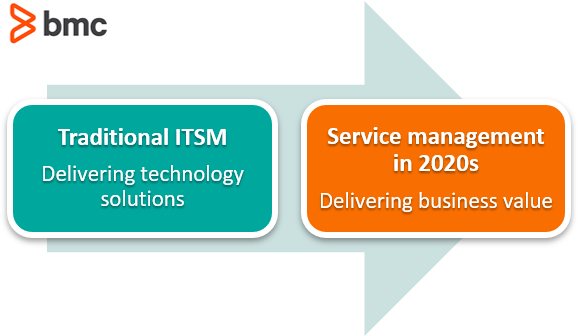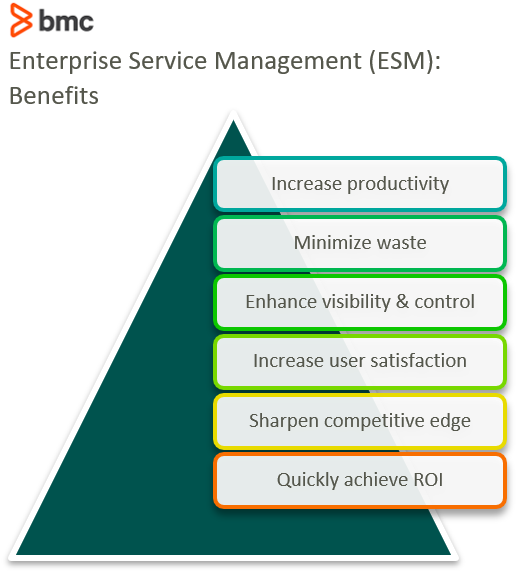To successfully adopt new processes, companies need to roll them out with simple, catchy names. Enterprise service management is one such example. The term enterprise service management (ESM) may be new, but the concept isn’t—and you’ll hear this a lot from ESM adapters and promoters.
Let’s take a look at enterprise service management, including:
- Defining ESM
- Comparing ESM and ITSM
- Exploring benefits of ESM
- Outlining ESM implementation
- Choosing ESM tools
ESM meaning
The basic premise of ESM is not complicated:
Enterprise systems management is the practice of applying IT service management to other areas of an enterprise or organization with the purpose of improving performance, efficiency, and service delivery.
In short, it’s taking what works well in IT service management (ITSM) and applying it to the entire enterprise. ESM mirrors components of ITSM such as:
- Service management theories and principles
- Structures and technologies including:
- Service desks
- Incident request and change management software
- Self-service (knowledge management, chatbots, etc.)
- The use of automation

ESM example
Here’s an example: Your IT teams begin to automate service requests and certain processes. This does two things:
- It helps your customers—the colleagues who rely on your IT to provide software, processes, and tools.
- It helps your IT teams directly, improving their workloads and streamlining service delivery.
The key here is the use of automation. IT teams that can provide easy, user-friendly ways to access knowledge means your users can quickly solve their own problems instead of waiting for direct help. With just a little common sense, business areas beyond IT have realized they can automate and gather collective knowledge, using ITSM principles, in order to improve performance and service delivery.
What ITSM principles apply?
Short for IT service management, ITSM is the way your company delivers services. According to Joe Hertvik,
ITSM includes all the activities, policies, and processes that organizations use for deploying, managing, and improving IT service delivery.
Traditionally, ITSM focused solely on IT services: setting up computers and printers, offering service desk help when you’re stuck. But the digital age means that we’re always using technology—nearly all work is tech-enabled—so ITSM now encompasses all services that your business offers, from software development to marketing and sales to finance and HR.
Instead of IT being an area that fixes problems, only visible when other business functions need them, ITSM helps the entire business see the IT team as the service provider that enables the entire business to efficiently meet both team-based individual goals and wider business goals.
Think of the ITSM practice just like any business that sells a service or product. These businesses combine materials, tools, and expertise to deliver a product to external customers. In ITSM, the IT team uses the same resources to deliver a product as efficiently as possible to its own customers—internal teams and organizational functions.
As long as you’re delivering some IT service or product, you’re taking part in IT service management. At the end of the day, the main objectives of ITSM are to structure the design, implementation, and delivery of any service in a way that:
- Improves the efficiency of operations
- Mitigates risk
- Facilitates strategic planning to support business needs
ESM vs ITSM: What’s the difference?
ITSM is a deliberate way of managing and delivering IT services to your customers—which might include both internal and external customers. But ITSM strategy does not inherently apply to organizational processes beyond IT. That’s a key difference between ITSM and ESM.
You might incorporate one or several ITSM frameworks into your ITSM practice. The most recognized is ITIL®, a worldwide standard of best practices. Organizations can use these best practices to integrate IT to their overall business goals in a way that:
- Delivers and co-creates value
- Maintains a standard level of competency
- Meets customer expectations
- Beats competitor offerings
Aligns with legal and regulatory requirements
The latest iteration, ITIL 4 demonstrates the importance of planning, implementing, and measuring in a way that supports continuous improvement (CI). ITIL 4 coined the Service Value System and 4 Dimensions in order to evolve established ITSM practices for the wider, modern contexts of:
- The customer experience
- Value streams
- Digital transformation, incorporating DevOps, cloud, and agile approaches, among others
Inspired by the deliberate approach of ITSM strategy, ESM broadly brings these service management strategies to the rest of the business, applying them to enterprise teams beyond IT. ESM takes the same goals of ITSM, improving efficiency within service design, transition, and efficiency, to support business needs and increase user satisfaction.
ESM encourages the company to think of everything as a resource or work that has some status. That’s why ESM-based systems solutions track:
- Business resources, including people, parts, and assets
- The status of service requests, orders, repairs, and more
OK, so ESM has a lot in common with ITSM. But there are some differences. A key one is that ESM encompasses the processes or mandates that may not be necessary within IT service management.
For instance, some departments, like human resources (HR) or accounting, may require a minimum level of data privacy or added flexibility in their templated answers to requests. Depending on your industry, external mandates could come into play as well, requiring service management solutions to meet safety and compliance regulations, such as legal protection or medical privacy as associated with HIPAA.
And, with the advent of GDPR, countries around the world are instituting minimum levels of data privacy, regardless of industry.
Benefits of enterprise service management system
The benefits you’ll experience from ESM will depend on how widely and seriously you implement its tenets. Common benefits to implementing ESM across many organizational processes and departments include:

- Increasing productivity. Using an easy ticket tracking process enables teams to respond to requests quickly, all in one place, leaving inboxes (and employees’ minds) less cluttered.
- Minimizing waste. Mapping processes helps define activities, resources, and more by how much value they add. Eliminate the activities that add no value. When you know exactly what is needed, you avoid redundant surpluses. As you mature this process, you can evolve into a continuous improvement workplace, for long-term improvement and optimization.
- Enhancing visibility and control. Once you establish reporting techniques, reliable metrics offer a high level of visibility, so you can easily identify problem areas.
- Increasing user satisfaction. As processes help define roles and responsibilities, internal users will become more satisfied with request expectations. (Satisfied internal users will spill into your external customers, who will also see this improvement.)
- Sharpening your competitive edge. By 2025, companies will need to embrace intelligent, tech-enabled systems in order to thrive during unforeseen changes.
- Increasing ROI on ITSM solutions. With more business units using the same or similar ITSM and ESM solutions, the ROI increases drastically.
Who can use and benefit from enterprise management services?
Proponents believe that practically all business units can use ESM. It is the responsibility of every team and the whole organization to decide who can most benefit from it—and who to prioritize when rolling out ESM processes.
To start implementing ESM practices, good candidates can be any team who:
- Receives large number of requests regarding the same topics
- Delivers time-sensitive requests that must be tracked and managed
- Acts as a gatekeeper for processes, for instance someone who provides approval or moves forward an action
- Provides frequent standard reports
Here are some common examples:
- Customer service. Handling high volume of requests, some that are quick and easy to solve while others require research and advanced expertise.
- Human resources (HR). Handling requests for leave, changes to health plans, training and staffing, salary enquiries, and on-boarding new employees.
- Accounting and finance. Approving expenses, sending invoices, tracking payments.
- Creative and marketing teams. Creating stock images and templates, applying product changes to the website, tracking deadlines for deliverables.
- Legal. Reviewing and approving documents, requests for standing contracts/forms, and certifying documents.
- Purchasing/procurement. Processing purchase orders, building quotes, and authorizing discounts and price adjustments.
- Security. Onboarding new employees and performing security checks and audits.
- General administration. Requesting office supplies, managing printing and courier services, and tracking meeting rooms.
- Facilities/building services. Managing requests for repairs, office relocations, and furniture needs.
Long-term, most every business unit is providing an internal service to the organization, so ESM practices can be applied.
How to implement ESM in any organization
ESM is unique in that each team that adapts its theories and practices can customize it to their service delivery. Still, initiating the implementation of ESM can be tricky. Here are some tips to help justify or ease the transition:
- Justify the need for ESM in business terms. Indicate where you can save money, reduce workloads, and improve efficiencies, leading to an overall increase in business efficiency
- Each department owns their ESM rollout—it’s not an IT project. While ESM has historical context in IT teams, it’s not up to IT teams to implement ESM systems for other company functions. Each team must embrace what ESM can do for them specifically. It’s also important to recognize that ESM is not only about implementing a tool or software system.
- Differences are welcome! There is no one-size-fits-all approach to service management that will be appropriate for all business areas. Some teams may require more automation while others require more flexibility.
- Share success stories across the enterprise. Showing how your team automated repeatable tasks and made project management easy frees them up to do more satisfying work. Share this story—and get inspired by other teams who’ve done the same.
Taking advantage of enterprise service management theories and practices will lead to the continuous and long-term development of flexibility, ROI, and continuous improvement, both for those who employ ESM principles and the users and customers who benefit from them.
Choosing enterprise service management tools and solutions
Companies and enterprises around the world are embracing the ESM approach. Fortunately, many ITSM software providers are creating better, ESM-enabled solutions, making it easier for IT and business units to align.
When choosing ESM tools to support your ESM implementation, look for features such as:
- Cloud-native, core ITSM capabilities that offer innovation (such as the integration of DevOps into your service management activities)
- Expanded support for non-IT use cases
- Service management intelligence, such as machine learning, change management optimization, and self-service tools and chatbots
- Business workflows
- Mobile functionality
Forrester Research annually evaluates the leading ESM solutions providers. In fall 2019, the Forrester Wave broke the 15 most significant ESM providers into four categories:
- Leaders
- Strong Performers
- Contenders
- Challengers
Of six Leaders, BMC Helix is the strongest current offering for ESM tools. With a core focus on ITSM and IT Operations that’s decades in the making, BMC Helix is the leading option for Cognitive Service Management.
Remember that the tool is only a tool—whichever solution you choose must be accompanied by cultural changes and leadership that embrace ESM principles.
Service management for the whole enterprise
Embracing enterprise service management is one way to become an Autonomous Digital Enterprise. ADEs are enterprises that embrace intelligent, tech-enabled systems across every facet of the business to thrive during seismic changes.
Additional resources
For more on this topic, explore these resources:






